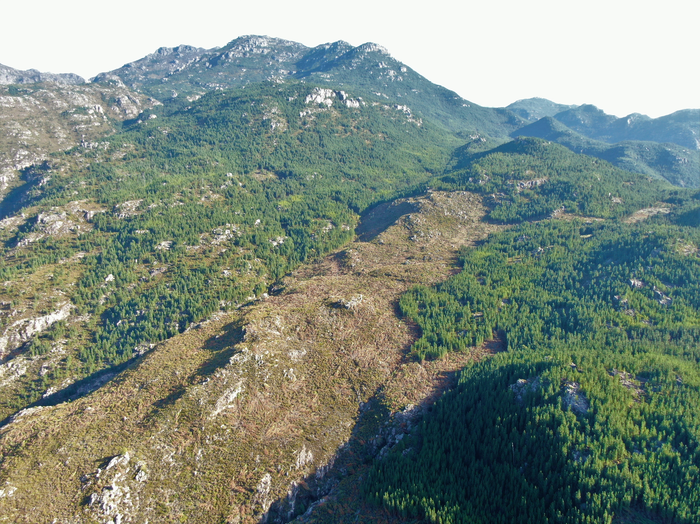A new study, directed by Dr. Petra Holden from the African Climate and Development Initiative (ACDI) at the University of Cape Town (UCT), has demonstrated how catchment restoration — by controlling alien tree invasion in the mountains located in the southwestern Cape — could have diminished the effect of climate change on low stream flows during the “Day Zero” drought in Cape Town.
 Recently cleared areas of invasive alien trees from the Cape Mountains. Image Credit: Cape Winelands Biosphere Reserve.
Recently cleared areas of invasive alien trees from the Cape Mountains. Image Credit: Cape Winelands Biosphere Reserve.
Climate change is triggering extreme weather conditions like floods and droughts. Solutions based on nature, like catchment restoration, require working with landscapes and ecosystems to resolve societal issues. These issues include the effects of climate change on water resources.
Thus far, studies have not separated the role of nature-centered solutions in minimizing extreme events on the availability of water due to climate change effects caused by human activity from that of climate variability caused by nature.
This new research, by an African-based group of researchers from the south, aims to inform water resource adaptation planning using the Day Zero drought of Cape Town as an example. Their emphasis was on South Africa’s standard type of catchment restoration — management of invasive alien trees.
Details of the study have been published in Earth Communications & Environment, a Nature portfolio journal.
“Invasive alien trees have higher transpiration rates, compared to the native vegetation of the Cape mountains, and thus reduce streamflow”, Holden explained.
The researchers connected climate prototypes and a hydrological model to mimic river flow during the “Day Zero” drought. They then examined what the severity of the hydrological drought would have been had there have been no human-triggered climate change.
Their emphasis was on the effects of climate change and management of alien trees on river flow from catchments in the mountains that supply water to the dams vital for Cape Town’s water needs.
Holden shared: “Existing studies do not isolate the effect of nature-based solutions on the anthropogenically derived (i.e., human-derived) portion of climate change, especially for drought events that have already occurred. Few studies attribute biophysical impacts to human-caused climate change impact on drought events while simultaneously investigating the role of nature-based solutions in modulating this impact.”
This new study reveals that climate change lowered the flow of streams for the duration of the drought by 12-29% compared to a world without human impact on the climate. Additionally, it reveals that eliminating alien trees that existed in the catchments prior to the drought event could have decreased the anthropogenic climate change effect on river flow, but the effect was subject to the extent of the incursion.
Eliminating moderate levels of incursion (for example, 40% of such trees in certain catchments) would have brought about a 3-to-16% amelioration of the human-triggered climate change effect on river flow. Preventing alien trees from spreading from existing levels to full catchment incursion prevented extra reductions of 10-27% in river flow because of anthropogenic climate change.
The team also discovered that the effect of climate change was enlarged because of catchment hydrological processes. For instance, the decreases in river flow (12-29%) were larger than the decreases in rainfall as a result of anthropogenic climate change (7-15%).
Regardless of the role played by evapotranspiration in drought events, the scientists discovered some but not a big impact of climate change on reference evapotranspiration.
This is a critical study for underlining the power of quantitative evaluations for notifying climate change adaptation planning. The scientists could demonstrate that catchment restoration lessened the effect of anthropogenic climate change but could not eliminate the full signal of human-triggered climate change totally, even under existing levels of warming.
Subsequently, the scientists stress that it is important to unite nature-centered solutions with other adaptation policies and decisions for water resource planning to fight the accelerated effects of climate change.
“Teasing out the contribution of adaptation strategies—be they nature-based or not—for buffering society from human-driven versus natural variability in climate can be challenging. However, it is important to inform adaptation planning so that climate risk management strategies can be combined in ways that consider thresholds and limits to change,” concluded Holden.
Journal Reference:
Holden, P. B., et al. (2022) Nature-based solutions in mountain catchments reduce impact of anthropogenic climate change on drought streamflow. Earth Communications & Environment. doi.org/10.1038/s43247-022-00379-9.